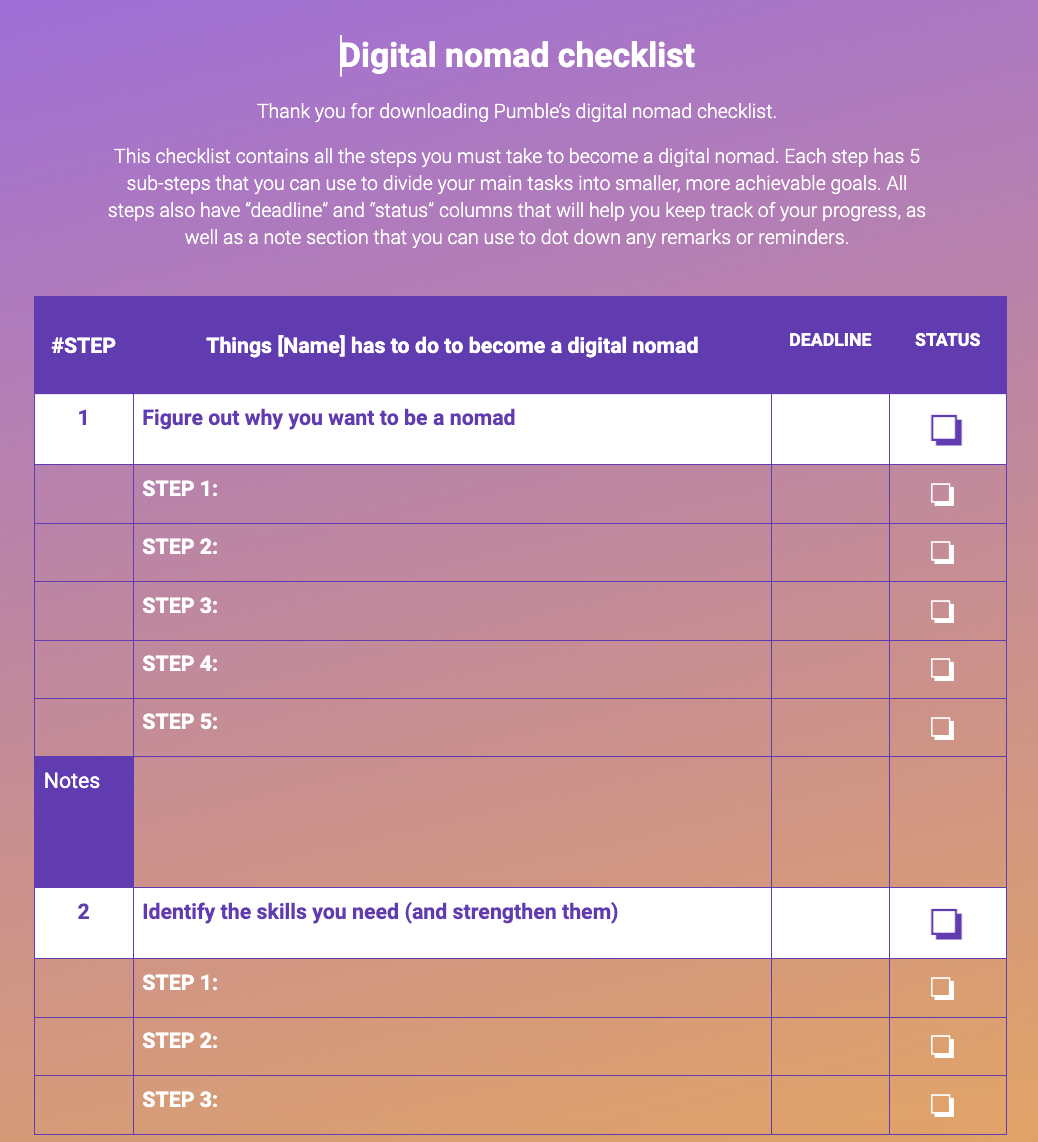As a movement, digital nomading started way back in 1984, with Steve Roberts, a freelance writer who biked across America while working on his state-of-the-art Radio Shack Model 100 computer.
Today, that digital nomad movement is 35 million strong!
It’s hard to believe that in just short 4 decades, our work culture evolved so much to allow millions of people to work remotely and travel the world.
But, it did! All you really need to pull it off is the Internet, a laptop (hopefully, a model that’s a bit stronger than what Steve Roberts had), and various tools for remote work that allow you to stay connected with your coworkers.
However, combining work with frequent travels, as appealing as it is, remains just a dream for many people. Some simply can’t pull it off while others don’t know where to start.
Well, if you fall into that “others” category, we have some great news! Today, we’ll go over everything you need to know about becoming a digital nomad, including:
- Which steps you need to take (plus a digital nomad checklist you can use to track the steps)
- Expert tips from past and current nomads that will help you avoid the same mistakes they made — and more
Let’s get started!

20 Steps to becoming a digital nomad (no experience needed)
The road to becoming a nomad is often different for each individual. Some people stumble into it while others prepare for months (or even years).
If you’re the type of person who likes to be prepared, you’ll be happy to hear that we have a whole list of steps you need to take to become a digital nomad.
Step #1: Figure out why you want to be a nomad
Before you do anything, try to ask yourself some difficult questions to find out WHY you want to be a nomad. Knowing the exact reasons you want to become a digital nomad will make it easier for you to endure this adventure because those reasons will become your driving force.
The best route you can take here is to try to be as specific as possible. As Shane Dayton, a digital marketer who’s been living the nomadic lifestyle since 2005, says, specific reasons will be a positive indicator.

“Ask yourself why you want to be a digital nomad. If your answer is general like travel, you’re not ready. If it’s specific, like, “Hike the X trail in Portugal” or “Explore the coffee culture/digital nomad space of Chiang Mai” then you’re in a much better place to start.”
Of course, you can stick to general reasons you want to be a nomad (like traveling, learning new languages, etc.) — there’s nothing wrong with that. However, specific reasons will become better motivators.
Furthermore, they’ll make it easier for you to execute some of the following steps. For example, in the example Dayton provided, if you already know you want to hike a specific trail in Portugal, you also know that country will be on your itinerary (maybe even your starting point).
🎓 Pumble Pro Tip
If you have a bucket list of countries you always wanted to visit, and you’re slowly turning that list into your digital nomad itinerary, you’ll be happy to hear that plenty of countries offer digital nomad visas. To find out more about these special visas and check whether your dream destinations are on that list, read the following guide.
Step #2: Identify the skills you need (and strengthen them)
Naturally, to become a digital nomad, you’ll need to have a job you can take on the road with you. However, if you don’t have one yet — that’s OK.
You can always get one, provided that you have and are willing to hone the necessary skills.
A past digital nomad with years of experience, Liam Rafferty, cites specific skills which are a necessity for every digital nomad.

“Transforming into a digital nomad demands a blend of skill-building, strategy, and adaptability. Sharpen marketable skills that are viable in the digital realm, such as SEO, content creation, or social media management. Equally essential is a strong digital foundation, consisting of effective project management tools, a reliable laptop, and secure internet access.”
Generally speaking, there are two types of skills that every digital nomad needs:
- Hard skills and
- Soft skills.
Hard skills are the technical skills that you’ll use to get a job. Those include:
- Digital skills,
- Content creation,
- Writing and editing,
- IT skills,
- Design,
- Programming,
- Marketing and sales, and
- Social media management.
Of course, you don’t have to have a firm grasp of all of these. However, keep in mind that strong digital skills are a necessity for most nomads.
Soft skills are actually transferable skills that you’ll use both during work and in your everyday digital nomad life. Some of the most important soft skills for digital nomads are:
- Communication,
- Time management,
- Organization,
- Self-discipline,
- Adaptability, and
- Problem-solving.
It’s vital that you identify which hard and soft skills you already possess and work on strengthening them.
To improve internal communication in your team, try Pumble
Step #3: Research the job market
Although soft skills are quite important for a digital nomad (time management, for example, will allow you to maintain a good work-life balance even while traveling), it’s the hard skills that are the money-makers.
But, before you throw yourself head-first into simultaneously learning all there is to know about both programming and content creation, do some research.
Take a good look at the job market and see which skills or strengths will give you the highest chances of getting a remote job.
Step #4: Establish a reliable remote income
After you’ve done your market research and strengthened the necessary skills, it’s time to get a remote job. Finding one won’t be as big of an issue as it was 10 or 20 years ago, given that the number of people working remotely has increased by 159% since 2009.
However, when you get a remote job, make sure your employer is actually OK with you working from the road.
Employers who hire remote workers usually assume that their employees will be working from home. You must make it clear that you’ll be working from various locations (and often from different time zones).
We spoke about this to Chelsea Ashbrook, a digital nomad of many years. She sees this as an achievable goal. All you have to do is highlight the symbiotic relationship between digital nomading and remote work.

“[After deciding to become a nomad] convincing your employer is the next hurdle. It’s all about presenting a well-rounded argument and highlighting the potential mutual benefits. My pitch focused on the possibility of expanding the digital experience team’s understanding of different markets by working from there and the flexible timing that ensures round-the-clock availability for global clients. Needless to say, it worked.”
Making your employer or clients aware that you’ll be a digital nomad is essential because, otherwise, you’re just lying to them. Your credibility is one of your most valuable commodities and you shouldn’t squander it so lightly.
What’s more, it’s not easy to maintain a ruse of working from home while you’re actually exploring Colombian beaches. All it takes is one urgent meeting to blow your whole lie into smithereens.
Step #5: Save up (a lot)
Having a reliable income from a job that allows you to work remotely isn’t enough.
In order to travel, you need money. And before you go all Meryl Streep in Devil Wears Prada on us here (Money? For traveling? Groundbreaking.), you need to understand that in order to prep for digital nomading you’ll need quite a lot of money. The starting costs alone will probably deplete your savings!
Sure, you can be a digital nomad on a shoestring budget, but you’ll have quite a bit of difficulty traveling anywhere by just leeching your monthly income.
Instead, you’ll need to make a solid financial plan that includes hefty savings. You’ll later use those savings to fund your travel and accommodation expenses and use your income to live off of.
A digital marketer who recently started traveling while working, Neha Gharpande, claims that having a financial safety net is essential.

“The digital nomad lifestyle can be unpredictable, especially when it comes to financial stability and finding consistent work. It’s essential to have a contingency plan and be adaptable to overcome potential challenges.”
A past digital nomad and current full-time travel blogger, Shawna Newman, agrees with Gharpande and adds that your financial stability depends on how well you prep for your digital nomad adventure.

“My #1 tip is to determine how much money you’ll need to save up, and then double it because you never know what might happen. The first apartment I rented was in Seville, Spain for 3 months. There was non-stop construction noise in the unit directly above it that resulted in me having to forfeit the money I’d paid and move to a new short-term rental. Also, make sure that you have backup ideas for how to earn money on the road in case your income stream dries up.”
Step #6: Do research
Although you’re arguably doing research right at this moment, while reading our guide on becoming a digital nomad, this step is more about deep research.
You need to figure out the following:
- Where you want to go,
- How long you want to stay, and
- What you want to experience during that time.
To answer these 3 questions, you’ll need to research pretty much everything. Any location you’re interested in will need to go through a thorough checkup. You’ll need to look into:
- Whether they are a welcoming country,
- Whether they are a safe country (especially if you’re a woman, a member of a minority group, or a solo traveler),
- Whether you need a visa to enter (or work there as a digital nomad),
- What the internet is like,
- How expensive or cheap the cost of living is,
- What the infrastructure is like,
- Whether there are any coworking spaces there, and
- Which destinations are the best for digital nomads.
All of these will (or at least should) factor into your decision to pick a specific location or a country to travel to and work there.
Ashbrook explained why picking a location is so important.

“First, the journey to becoming a digital nomad, incredible as it may seem, begins with picking the right spot. It’s not as simple as spinning a globe and planting a finger. It’s about understanding local legalities, safety, and even personal preferences. I remember my first stop, Bali. I chose it for its buzzing digital nomad community and the exotic Balinese food. But more importantly than that, it was about safety and ease of living, because I’m a solo female traveler.”
So, try to take everything into consideration.
Step #7: Research visas thoroughly
After you finish your research, the next step is — research!
Yeah, digital nomading isn’t all about frolicking in the fields and working from beaches. It actually requires a lot of planning, logistics, and, as mentioned, research.
So, the next thing on your agenda should be visas.
If you plan to spend more than 90 days in one country, you will need to look into getting a visa of some sort before you get there. Ideally, you’ll be heading to a country that offers a digital nomad visa — a specific visa that allows digital nomads and entrepreneurs to live and work in a specific country while enjoying specific benefits.
If you’ve picked a country that doesn’t have a digital nomad visa, you’ll most likely be allowed to stay for a period of 90 days. The exceptions to this rule exist, but they aren’t always positive. For example, if you’re heading to Europe, keep in mind that you’re only allowed to stay for 90 days in the entire Schengen Area.
Visas will be a particularly complicated issue if you don’t have what’s known as a “strong passport.”
We spoke about this to Thirumal Motati, who has been traveling the world as a digital nomad for the past 8 years. He had some words of wisdom as well as a potential loophole.

“As a digital nomad with a weak passport, I highly recommend obtaining a US visa before leaving your job to embark on this lifestyle. US visas are incredibly valuable for digital nomads with weak passports, as they grant visa-free access to countries that would otherwise require visas. This includes popular digital nomad destinations like Mexico, Colombia, and Georgia. It is generally easier to secure a US visa while still employed rather than when already on the road.”
🎓 Pumble Pro Tip
Picking a starting point for your digital nomad journey isn’t easy. However, you can drastically narrow the list down by focusing on the countries that offer digital nomad visas. To find out all the details about specific DN visas that countries like Spain, Portugal, Taiwan, Bali, or Costa Rica offer, make sure to check out the page below!
Step #8: Plan ahead for travel and accommodation
Your travel and accommodation plans will differ depending on:
- Where you end up going and
- How long you plan on staying there.
So, let’s say that you’ve made a plan to go to Portugal and stay in different cities every week. You’ve booked the tickets for the initial travel (from your home country to Portugal) and a hotel for the first couple of days, but nothing else. That’s OK! Since you plan on moving around quite a lot, booking accommodations and making travel arrangements on the spot is a decent idea.
However, if you plan on staying for a longer period, booking in advance is vital.
That’s especially true in countries like Croatia and Greece, which heavily rely on tourism income. Tourism in Croatia makes up 19% of the gross national income, so it’s expected that the entire country adapts to the tourist season.
Sadly, that adaptation often manifests itself as a massive increase in prices. Croatia has a high and low tourism season, and renting an apartment or booking accommodation during those 2 seasons means going through 2 vastly different experiences.
Finding accommodations will probably be the most difficult (and expensive) issue. Here’s what Manisha Snoyer, a past digital nomad, had to say about that.

“I find that the hardest part of being a digital nomad is finding housing. There are lots of options on Airbnb, but it takes a long time to sift through it all. Once you’re on-site, you can find deals on the local Facebook and Whatsapp expat groups or by connecting with locals. You just have to accept that finding housing will take time unless you have an unlimited budget. So, it’s good to stay in a place for at least a month at a time so you’re not constantly looking.”
Step #9: Figure out how you’ll pay your taxes
When it comes to taxes, there are two things you need to worry about:
- Whether you’ll be taxed in your home country, and
- Whether you’ll be taxed in your destination country.
The main question you have to ask here is whether both your country and the country you’re going to have a citizenship-based taxation system or a residency-based one.
For example, the US has a citizenship-based system, which means that you’ll have to declare and pay your taxes in the US even if you spend the entire year abroad. Now, this won’t be a problem if you go to a country that has a double taxation agreement with the States or a digital nomad visa that offers tax benefits. For example, the Croatia digital nomad visa exempts all digital nomads from income tax.
Sadly, you won’t get the same treatment in other Mediterranean countries. The Greece digital nomad visa, for example, doesn’t offer the same benefits to digital nomads. However, Greece has a double taxation agreement with quite a few countries, including the States. So, you will be paying taxes, but at least you won’t pay them twice!
Step #10: Test it out first
OK, if you’ve followed the steps, you’re probably feeling ready to embark on your journey right about now.
You found a remote job, convinced your boss to let you work on the road, did research, found your perfect location, and even figured out the visa and tax systems. Surely you’re ready, right?
Not really. In fact, you’re only halfway there.
The next step is one that many nomads recommend — testing the waters.
A remote worker and a self-proclaimed travel enabler, Michal Wieczorek, urges aspiring nomads to take a realistic look at the situation before them. Not everything is as idyllic as it seems.

“Social media is filled with [posts of] people going to exotic locations for months at a time. But they don’t show poor internet connectivity, accommodation that doesn’t quite fit the description, or other issues.”
Due to that, Wieczorek continues, it’s always best to do a trial run before you throw yourself into the digital nomad lifestyle with all your might.

“If this is your first foray, go stay with a family member or friend in another city, state, or neighboring country for a few days or a week. This counts and is a great practice! You can even go to local coworking spaces or similar areas and see how you like it.
This allows you to start small and learn what you like, what you need, and, more importantly, what you don’t like! You’ll know the true state of your accommodations, internet speed, and infrastructure, and have a social network already in place. You’ll see if your equipment — laptop, external devices, etc. — is comfortable and capable of wear and tear or if you need to invest in other devices.”
Step #11: Network
Wieczorek was right to mention a social network because it often proves to be a lifeline for many digital nomads.
While preparing for your adventure, it’s important that you create a network of contacts. These should include other professionals in your field of expertise and other digital nomads.
Networking with others from your profession is essential because you want to have as many people to turn for help to in case you find yourself attending your own exit interview somewhere on a beach in Bali. If you lose your income while you’re traveling, you’ll need to supplement it as soon as possible. A great network of contacts will come in handy there.
Of course, reaching out to other digital nomads is also a good idea. Getting firsthand experience as well as advice from them will prove invaluable during your prep.
Connect with third-party collaborators over Pumble
Step #12: Figure out the necessary budget
As you’ll find out later in the text, being financially responsible is one of the must-have traits of every digital nomad.
When you spend your life traveling around without a solid support system, you really need to prepare yourself for worst-case scenarios. That, in turn, prompts you to be more fiscally responsible, which includes setting and complying with a strict budget.
There are several different things you need to factor in when setting a budget for your travels:
- Your savings,
- Your monthly income,
- Your monthly needs (like accommodation, transportation, internet, groceries, etc.),
- Your monthly wants (like traveling, sightseeing, various activities, etc.) and
- The cost of living in your country of choice.
Of course, the easiest way to ensure your digital nomad adventure goes as smoothly as possible would be to opt for a destination that has a low cost of living. However, just because a country is cheap to live in doesn’t mean it’s a good destination for you. It’s also important to factor in the quality of life and find an acceptable overlap between the two.
Luckily, the most popular digital nomad destinations are usually the ones with a lower cost of living.
🎓 Pumble Pro Tip
Are you looking for a great digital nomad destination that is affordable and offers an amazing quality of life? Then check out our guides below!
Step #13: Simplify your life
If you’re a sentimental person who likes to fill their living space with mementos and knick-knacks, you’ll find the next step particularly hard.
When preparing to become a digital nomad, you will have to downsize everything in your life. Most of the stuff you own will have to be left behind in storage or with friends and family. So, it’s best to start decluttering and emotionally detaching from it right now.
Another important point is that you’ll probably have to let go of your apartment and car. The core value of digital nomads is that they are location-independent. Driven by a desire to escape the traditional work environment, they leave everything behind for a life of traveling (at least temporarily).
Depending on how long you’re planning on doing said traveling, keeping a long-term lease and a vehicle in your home country will cost you quite a bit and it will put a dent in your budget before you even start the month in a new country.
So, if you plan on traveling for a while, it’s best to switch to a short-term lease that you can cancel when you embark on your journey.
Step #14: Digitize everything
When you become a digital nomad, you abandon your home base, so to speak. That means that you have to take all your essentials with you and carry them with you as you travel.
However, “essentials” aren’t just wardrobe, electronics, and cosmetics. When you decide to become a digital nomad, you also have to take your mail, accounting, and banking with you.
Luckily, you can easily do that by digitizing everything.
Since you’ll have to sort everything in your life on the go, it’s best to start digitizing everything right away.
Sort out a virtual mailbox, so you don’t have to beg friends and family to get your mail for you. Also, look into online banks that you can use both at home and abroad. Make sure to double-check if they have any hidden fees for withdrawing money or making payments in a foreign country (since those would gut your budget, considering that you’ll only be making payments in a foreign country).
It’s also a good idea to get a VPN that will keep your laptop and your files protected. Oftentimes, you’ll find yourself working while connected to a public wifi, so it’s best to protect yourself and your data from others using the same network.
Step #15: Get the right equipment
If you’ve done the trial run we suggested in step #10, you’ll already know whether your equipment can withstand a digital nomad lifestyle. If it can’t, you better budget for an upgrade.
A typical digital nomad will always need a standard set of equipment that includes:
- A laptop,
- A charger,
- Headphones,
- Hard drives,
- SD cards,
- Power banks,
- Travel-friendly (and anti-theft) backpacks,
- Charging cables,
- Adapters,
- An e-reader, and
- An extra phone.
Of course, depending on your job (and hobbies), your equipment might be more or less extensive than this. Either way, ensure that it’s fit for traveling.
Step #16: Get your documents in order
Since you won’t be home for a while, you should gather all the documents you need (or might need) and make copies to have.
Here are the most important documents you’ll need no matter where you’re traveling to:
- Your passport,
- Your driver’s license or another form of ID,
- An international driver’s license (if you can obtain one),
- Birth certificate, and
- Your medical records.
If you opt to apply for a digital nomad visa somewhere, having at least some of the documents with you will make things a bit easier. Of course, digital nomad visas usually require a lot more documentation than we stated above (like the Thailand digital nomad visa or the Italy digital nomad visa, for example).
Step #17: Get insurance
Another document that you’ll need to have no matter where you’re going is insurance. Travel and health insurance are of the utmost importance for any digital nomad because they give you peace of mind in case something happens to you.
Medical emergencies aren’t that common, but it’s best to be prepared for them.
Not to mention, insurance is a main requirement of all digital nomad visas. Therefore, if you opt to apply for one of them, you’ll need to get insurance anyway.
Step #18: Figure out emergency backup plans
And, while we’re on the subject of medical emergencies, it’s also important to mention emergencies in general.
One of the final steps of your prep should definitely be making contingency plans.
You’re going to be away from home, most likely all alone, and without a support system. That means that you’ll need to plan in advance for emergencies. So, figure out what you’ll do if you get seriously ill, are in need of surgery, if you lose your job, if a family member becomes ill or worse, etc.
Nobody likes to think about these things, but they are an integral part of life. Not preparing for them would be denying reality.
Step #19: Dodge naysayers
Arguably the most difficult step will be to dodge all those Negative Nancies in your life who will be quick to tell you that you can’t do this.
If you want to, you can. These 20 steps are all you have to do.
Being a digital nomad isn’t easy. There are quite a few downsides to the lifestyle. However, there are also more than a few benefits. At the end of the day, all that matters is whether you want this or not.
Step #20: Make the leap
Finally, all that’s left is to make the final step and become an actual digital nomad.
If you’ve followed our step-by-step list, you should have everything ready now. All that’s left is to count down the days until your flight.
Arguably, those days will probably be the most nerve-wracking because there’s not much to do but wait. Try to stay calm and keep busy. You can spend your days by:
- Going over the final details of your plan,
- Trying to declutter a few more things (every little bit helps),
- Saying goodbye to your friends and family, and
- Checking to see if you’ve packed all the essentials.
Digital nomad checklist
As you’ve gathered by now, there are quite a few steps to becoming a digital nomad. What’s more, each of them is a task that you’ll most likely take weeks, if not months, to complete.
To help you keep track of your progress, we created a digital nomad checklist. The list has all the necessary steps you’ll have to take in order to become a digital nomad. In addition, it also offers you an opportunity to divide one step into several smaller tasks and note down important remarks for each step.
That way, you’ll be able to keep everything tidy and you won’t get overwhelmed.

You can download the Google Doc version of the Pumble digital nomad checklist down below.
🔽 Download our free Digital Nomad Checklist
Pro tips from experienced digital nomads
The best people who can offer advice and words of wisdom are, of course, other digital nomads. The Internet makes it easy for people to connect with each other, which is why you won’t have any trouble finding a digital nomad community that will be more than willing to share a few words about their experience with you.
Facebook groups (like the Digital Nomads group) are a great source of information. Just scrolling through them, you’ll find sage advice such as:
- Never flush TP down the toilet in developing countries.
- Always check your beds for bed bugs and don’t store your luggage under the bed (for the same reason).
- Learn how to ask for help in the native language.
- Keep liquids away from your technology (especially if you don’t have spares).
- Always check the exchange rate in several places.
- Don’t rely on the Internet when exploring and download maps beforehand.
- Be kind and polite when talking to the locals.
All of these statements will surely come in handy to all aspiring digital nomads. However, for the purposes of this article, we wanted to get something more substantial, which is why we talked with quite a few past and current digital nomads. We’ve included their opinions and advice throughout the article, but let’s see what else they have to say.
Tip #1: Sharpen your marketable skills
The first piece of advice any digital nomad will give you is to never stop learning and honing your skills. Those are, after all, your bread and butter, as they make it possible for you to live the life you chose to live.
Even if you have a remote job, it’s still a good idea to maintain some other skills and keep them sharp — you never know what’s going to happen. You might need to find a new job in the nick of time, so it’s best to be prepared.
Here’s what Raul Guizzo, a digital nomad who’s been on the road for the past 5 months, adds that you should also pay attention to what your strengths are:

“Find the overlap between the skills required for remote jobs and your own strengths. In my case, this was writing and editing skills, but for others, it may be coding or translation. Although it may take time to find the perfect match between you and a job offer, you have to just keep applying, be patient, and don’t get discouraged if you don’t get the job. Luck and timing are still two big factors in getting hired — digital nomad or not.”
Tip #2: Have the right mindset
As mentioned at the very beginning, before you can become a digital nomad, you have to figure out why you want to be one. Answering that question will also put you in the right mindset, which, as Kacper Rafalski states, is vital.

“Becoming a digital nomad is as much about your mindset as your skill set. It’s about being flexible, adaptable, and open to the unfamiliar. All in all, it’s an adventure, a chance to grow professionally while enriching your personal experiences. And remember, becoming a successful digital nomad takes time, patience, and resilience.”
Tip #3: Master time management
You only have 24 hours in the day, just like anybody else. But unlike most people, who have errands and regular life stuff waiting for them after work, you have adventure lurking around every corner.
In order to be as productive as possible, while also using your time for activities, exploring, and fun, you need to:
- Maintain a routine, and
- Build self-discipline.
That’s the only way you’ll be able to manage your life and get the most out of the digital nomad experience.
🎓 Pumble Pro Tip
Working remotely (especially while traveling) means that you’re constantly bombarded by distractions. To ensure you maintain your routine and boost your productivity, you’ll need some tricks up your sleeve. Read the top 15 tips on how to maintain your productivity levels while working remotely in the article below. 👇
Tip #4: Look into multiple income streams
One hands-on piece of advice that you’ll often hear is that you shouldn’t rely on just one income. Scott Russel, who spends his time traveling the US in an RV with his family, emphasizes just how important additional income is.

“The biggest hurdle to becoming a digital nomad is finding the stream of income or a job that will support your travels. One expert tip here is to look at many smaller streams of income versus [having] just one job/business. Multiple income streams are more stable and less overwhelming to reach your income needs than one job. For example, we are freelance writers, have a blog, work with tourism boards, [are] social media content creators, and brand influencers.”
Russel, who’s been touring the US for the past 8 years, makes an excellent point. However, Dayton warns about the potential downfalls of that strategy.

“It’s easy to become reliant on one source of income while traveling and if that contract is suddenly canceled, that can be a major struggle. While getting multiple streams of income is often given as advice, it’s hard enough creating one great stream of income, much less several.”
Tip #5: Build an online presence and a community
Loneliness and the feeling of being disconnected from the rest of the world are massive issues for digital nomads. That’s why it’s vital that you build an online presence and a community.
Having a strong online presence will help you both professionally and personally. Having your own website or a blog will help you connect with people and actively engage with them.
Building a community will happen naturally because as soon as you become a digital nomad, you’ll become a part of a vibrant community of like-minded individuals. Still, it’s important to work on nourishing the connection you have with other nomads by:
- Becoming a member of different online groups,
- Going to online and in-person events,
- Connecting with and maintaining contact with all nomads you encounter, and
- Lending a helping hand when someone asks for it.
Snoyer testifies just how vital staying connected is.

“The best thing I did was join the Facebook group for expats in the city I wanted to visit. I got invited to a New Year’s Party and then introduced to the semi-secret WhatsApp group that is a treasure trove of information.”
Tip #6: Embrace uncertainty
If you can, try to embrace uncertainty as a part of life. While you’re traveling around, plans will constantly change and evolve due to circumstances outside of your control. In order to survive, you’ll either have to learn to live with that or abandon the digital nomad lifestyle.
If this is something you struggle with, know that digital nomading won’t change that for you. As Alise Saunders, a digital nomad travel blogger, testifies, digital nomading can’t change who you are.

“The biggest disadvantage [of being a digital nomad] is that whatever you struggle with now, will be magnified as you travel. For example, if control is your issue, it will be intensified as travel plans change or things don’t go as you’d like them to. If you aren’t comfortable being by yourself and need others around you, you might miss constant social interaction, though this can be remedied by joining co-working and social groups.”
Tip #7: Always have backups
Considering that your electronics are what make it possible for you to earn your money, perhaps the most logical piece of advice is to ensure that it all works. Or, as Lewis advises, that you have spares.

“The one tip I have for digital nomads is to have extra equipment. Electronics are often a lot more expensive in other countries. Of course, having two computers isn’t realistic (although I have three), but having an additional portable monitor, an extra laptop charger, or an inexpensive backup phone is crucial.”
Extra tip: There’s no “one-size-fits-all” way to be a digital nomad
Finally, we have one extra tip for you — if being a digital nomad means something different for you, that’s alright. If your vision differs from what we described, that’s fine. There’s no one perfect way to be a digital nomad.
Digital nomading will only make you happy if you do it for the right reasons and in a way that fits your needs. Julie Rose, who has been on the road since 2020 and is a full-time traveler, says it’s even okay if you realize that lifestyle is not for you:

“Nomad life has been glamorized by influencers, but it’s not a magic pill and it’s not for the faint of heart. People can change their surroundings, they can change their habits, and they can change the company they keep… but the common denominator is themselves. If that’s where your discontentment stems from, living nomadically will probably make things worse, not better. However, remember that you can always reverse, update, or change course. If you’re finding that nomad life is not for you, as some people do, it’s okay. Learning and growth comes from the journey, not the destination. At least you’ll never wonder ‘what if.’”
Is the digital nomad lifestyle for you?
Sometimes people find it hard to make up their minds about whether this lifestyle is a good fit for them or not. That’s completely normal. 1 in 3 people resist change for various reasons.
If you’re still struggling with making a decision, here is a list of questions that might help you.
- Can you afford it?
- Do you like being alone?
- Do you need the constant support of your loved ones?
- How often do you like to change environments?
- Do you need a routine in order to be productive?
- How comfortable are you with volatility?
- Are you comfortable with change and not knowing what’s coming?
- Are you comfortable with approaching strangers?
- Do you need to control every aspect of your life?
- How do you handle stress?
- Can you live out of a suitcase? What about a backpack?
- Can you store or get rid of most of your stuff?
Carefully consider the implications of each of these questions and really consider what your answers are telling you. For example, if you can’t live out of a suitcase and you thrive when you have a strict routine, then maybe digital nomading isn’t the best option for you.
However, if unsure — it’s always best to consider the advantages and disadvantages of being a digital nomad first, before you make any decisions.
Advantages of being a digital nomad
Now that we know how you can become a digital nomad, let’s see whether you should.
As we mentioned, the digital nomad lifestyle comes with certain benefits. After all, 35 million people wouldn’t be bending over backward to live this way if the life didn’t come with a few advantages, right?
But, which perks can aspiring nomads expect?
Advantage #1: You have complete flexibility and independence
If you ask any digital nomad what they think the biggest advantage of their lifestyle is, they’ll almost unanimously tell you — flexibility.
The freedom that comes with digital nomading is unparalleled (bar being independently wealthy and not having to work at all).
A travel expert and founder of Why This Place, Nadia Podrabinek, who has been traveling since 2018, told us why she considers this to be the #1 advantage of the digital nomad lifestyle.

“The biggest advantages of being a digital nomad are its freedom and flexibility. You can work from anywhere in the world as long as you have an internet connection and a laptop. This means that you can explore new places, build relationships with people from different cultures and backgrounds, experience different climates, and enjoy various activities while working on projects that interest you. Remote work allows more time to focus on personal goals, such as improving your health and wellbeing or taking up hobbies that bring joy.”
Work from anywhere with Pumble
Advantage #2: You’re constantly traveling and experiencing adventure
Every day during your travels will be a new experience. The sense of novelty will never wear off because you’ll constantly be traveling.
Unlike an expat, you’re not moving to a different country to settle down there. Instead, you’re exploring, meeting new people, experiencing different cultures, and (relatively) quickly moving on.
Advantage #3: You have a lower cost of living
As mentioned, the trick to traveling in a sustainable way is picking destinations that have a lower cost of living. If you’re earning in a strong currency (like the euro or the dollar), you’ll be able to stretch a buck much easier than you would at home.
That same sentiment is also one of the driving forces for Corritta Lewis, an HR professional and a digital nomad of 3.5 years. Lewis has spent the past years traveling the world with her partner and child, and states that affordability is one of the bigger advantages of the digital nomad lifestyle.

“You can easily live in a country where your money is more valuable. You can have a better lifestyle at sometimes half or a third of the cost in your home country. Another advantage is the ability to save money. With a lower cost of living comes more discretionary income to save or spend on things you like to enjoy.”
Advantage #4: You learn financial responsibility
Being fiscally responsible goes hand in hand with being a digital nomad. Even if you opt for affordable countries, you’ll still have to be somewhat careful with money due to several reasons:
- You’re in a foreign country,
- You have no support system, and
- You can’t predict the future.
The digital nomad lifestyle comes with a lot of uncertainty. And, although that is a novelty that’s exciting, you still need to prepare for some scenarios that won’t be pleasant. The best way to do that is to be financially responsible and have enough money to bail yourself out of any problem.
Advantage #5: You have an improved quality of life
Imagine saying YES to everything you feel like saying yes to. Having coffee with a new friend you met at a seminar? Yes, you can go. Paragliding on a Wednesday afternoon? Yes, you can absolutely make it. Hiking the Amazonian trails over the weekend? Yup, you can do that too.
Being a digital nomad means you have more flexibility and spare time, which means you have enough room in your schedule to try out new things (or do things you already know you love). Furthermore, as mentioned, your cost of living is lower, so you have more money for leisure (or more traveling). You also don’t have to commute to work, which, as we all agree, saves a ton of time.
All of this improves the quality of life.
Advantage #6: You learn new skills and languages
Vacationing in a certain country doesn’t really give you enough time to get to know its culture and people. Luckily, digital nomading does!
When you spend a chunk of time in a foreign country, you have the opportunity to really immerse yourself in the society and even become a part of the community.
The best way to become one of the locals is to start learning the native language. Don’t worry, nobody expects you to be fluent, but you should learn enough to communicate with the locals and find your way around.
This is a massive benefit of the lifestyle. Being able to learn a language on the spot, in a country where it originated, is a huge privilege. What’s more, according to experts, it’s also the quickest way to learn a language.
Advantage #7: You’re constantly making new friends
Finally, even though it’s often quite a solitary activity, digital nomading can actually make you more sociable. Digital nomad communities are quite tight-knit, and members are looking out for each other. That’s why you won’t have any trouble finding other nomads and expats in any location. All you have to do is reach out.
Snoyer says that the possibility of making new friends is a benefit that she didn’t expect (but gladly welcomed).

“At first, I was worried I’d be lonely, but I was surprised at how easy it is to make friends! Everyone is starting out fresh so it’s easy to connect if you just say, “Hey, I’m going to try this restaurant today. Does anyone want to come with me?” I met my new best friend as a digital nomad in Split, Croatia.”
Disadvantages of being a digital nomad
Of course, being a digital nomad has its disadvantages as well. This lifestyle isn’t just about lounging on beaches and making friends all over the world.
So, let’s take a look at some of the most significant flaws of the digital nomad lifestyle.
Disadvantage #1: You’re away from loved ones
The top disadvantage is that you can’t regularly see (or sometimes even speak to) your loved ones. Lewis mentioned that being a digital nomad takes the biggest toll on relationships.

“As a digital nomad, it’s fun to live in different places and explore different cultures, but it sometimes comes at the cost of relationships. When traveling, it can be hard to maintain relationships with family or friends because of time zone differences. You can also work an unconventional schedule, which can impact both your job and your travels.”
Motati agrees and adds that the support system of your loved ones is something that most digital nomads miss.

“One of the significant drawbacks of the digital nomad lifestyle is the absence of a strong support system. When you are rooted in one place, you have the support of family and friends. During times of crisis, you can rely on their assistance. Consider the recent pandemic, for instance. Digital nomads, including myself, found ourselves stranded in countries under lockdown for weeks or even months. Nevertheless, this is the trade-off we accept in exchange for the freedom we enjoy.”
Disadvantage #2: You lack stability
Lack of stability is the dark side of the “flexibility” coin. Sure, you have the freedom to do whatever you want and work from wherever you want. However, that comes with significant levels of uncertainty.
Not having a permanent home is destabilizing in and of itself. When we pair that with a lack of a support system and the knowledge that you can lose your job or experience some other unpleasant event miles away from home, we get a recipe for a pretty unstable environment.
Disadvantage #3: You can easily experience burnout
Burnout is something that easily creeps up on digital nomads. Because nomads are constantly either working or exploring, they sometimes forget to take time to rest both physically and emotionally. What’s more, the constant fear of losing the income that makes their lifestyle possible drives them to work more (while also being under more stress).
Rafferty recognizes this as a common problem but also offers a solution.

“The digital nomad lifestyle can blur work-life boundaries, creating a risk of burnout. It can also disrupt routines, strain social relationships, and present logistical challenges. Managing client expectations across time zones and maintaining consistent communication can be especially challenging. But with a comprehensive plan and the right mindset, the digital nomad life can be a fulfilling journey.”
🎓 Pumble Pro Tip
Maintaining a healthy work-life balance and not slipping into burnout while you’re constantly on the move is a difficult task. It takes a lot of work, self-discipline, and self-management to avoid falling into an unhealthy routine while on the road. If you need a few extra tips and tricks, read these two Pumble articles below.
Disadvantage #4: You can struggle with laziness and procrastination
Another side of the burnout coin is laziness and procrastination. Some digital nomads fall into the trap that the media set for them, and they go on their journeys thinking they’ll just be going on a long-term vacation.
The reality, however, is much different.
When you’re a digital nomad, you have to balance work with not only life but also a massive amount of novelty that you’re eager to explore. That novelty, as well as a fear of missing out, drives some nomads to slack off and work less. They procrastinate with their work, ultimately jeopardizing their means to actually be a digital nomad and enjoy all the perks of that life.
Disadvantage #5: You have to figure out how to manage consistent communication
Communicating from a different time zone is an art form. The fact that the best destinations are usually quite far from your home (and thus your time zone) means that you’ll have trouble managing client/employee expectations and navigating time zones.
The best way to deal with that is to find a job that encourages asynchronous communication. That means that it doesn’t require you to work or communicate on a strict timetable.
–
If the disadvantages of being a digital nomads tip the scale towards a “No” in your case, all is not lost for your dream to travel the world while working – there’s always an alternative or two you can consider.
Alternatives to being a digital nomad
If you decide that the digital nomad lifestyle isn’t for you, that doesn’t mean you don’t have any options. You can still work and travel without completely abandoning your life in your home country.
There are 5 different options that you can explore — we’ll list them below.
- Teaching abroad — if you’re a native English speaker or know any other languages on a native or near-native level, you can look into temporarily relocating in order to work as a teacher. There are currently more than 250,000 English teachers abroad — why not become one of them?
- Working abroad — being an expat is a solid alternative to being a digital nomad, except that it comes with less adventure but more stability. For some people, it’s the best of both worlds, because it gives you the opportunity to immerse yourself in another culture without having to constantly be on the move and live out of a suitcase.
- Becoming an entrepreneur — if you’re looking for a line of work that will provide you with the same flexibility as digital nomading, then you should look into becoming an entrepreneur. You’d have the freedom to organize your time in any way you see fit and a better work-life balance than you would at a standard 9 to 5.
- Digital slowmad — somewhat of an opposite of a digital nomad would be someone who travels while working but settles in specific locations for longer periods of time. If you’re looking to experience new things without living the turbulent life that requires you to constantly move, then you should consider becoming a slowmad (a digital nomad who travels at a slower pace).
- Work exchange — if your company offers an opportunity for work exchange, you should consider taking it. This isn’t such a common occurrence, but work exchange is an excellent way to see a bit of the world without changing your entire lifestyle.
Enhance your digital nomad experience with Pumble
Embarking on a digital nomad journey opens up a world of opportunities for remote workers, freelancers, and entrepreneurs seeking both adventure and productivity.
However, navigating the intricacies of a new country and managing a remote lifestyle has its challenges. This is where Pumble comes into play as an invaluable tool for digital nomads.
Pumble is a team communication app with a suite of features tailored to the needs of remote teams and individuals.
Its direct messaging, file-sharing capabilities, video conferencing, and a multitude of other features facilitate collaboration across time zones, allowing digital nomads to stay connected with clients, colleagues, and fellow travelers regardless of their location.
Moreover, Pumble’s integration with other essential apps streamlines workflow management, ensuring efficiency and productivity on the go.
Whether it’s coordinating with local co-working spaces, organizing meetups with fellow nomads, or simply staying updated on work-related tasks, Pumble serves as a central hub for all communication and collaboration needs.
In essence, embracing tools like Pumble can enhance your digital nomad experience, enabling you to fully immerse yourself in your surroundings while staying connected and productive in your remote endeavors. With Pumble by your side, the possibilities for exploration and growth are limitless.
Take the first step towards efficient teamwork as a digital nomad — make a free Pumble account today!
How we reviewed this post: Our writers & editors monitor the posts and update them when new information becomes available, to keep them fresh and relevant.




